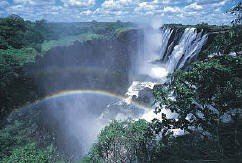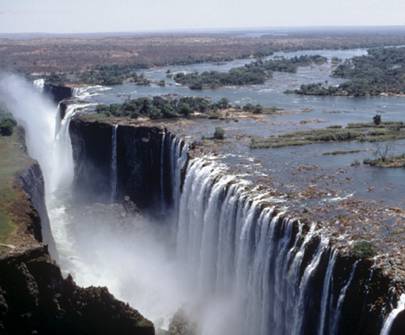The Discovery of Victoria Falls:
By Dr David Livingstone
The discovery of Victoria Falls is one of the milestones in the annals of history.
Dr Livingstone was the first white man to see the Victoria Falls. The grandeur and the beauty of the Victoria Falls and its surroundings moved him to write, “…scenes so lovely must have been gazed upon by angels their flight. The whole scene was extremely beautiful: the banks, the islands dotted over the river are adorned with sylvan vegetation of great variety of colour and form.” He was not satisfied that he had done justice with his description and added “…but no one can imagine the beauty of the view from anything witnessed in England. It had never been seen before by Europeans’ eyes.”

The Victoria Falls with its Rainbow
Understanding what he saw almost escaped him, “ No one could perceive where the vast body of water went; it seemed to lose itself in the earth, the opposite lip of the fissure into which it disappeared being only eight feet (about 2.7m) distant…” With wonder drolling from him he ventured to find out, “…creeping with awe to the verge, I peered down into a large rent which had been made from back to back of the broad Zambezi and saw that a stream of a thousand yards leaped down a hundred feet (33m) and then suddenly compressed into a space of 15 or 20 yards (5 or 9 m)…”
And then he couldn’t help exclaiming, “This is the most wonderful sight I had witnessed in Africa. In looking down into the fissure on the right of the island, one sees nothing but a dense white cloud, at the time we visited the spot, had two bright rainbows on it …the snow-white sheet seemed like myriads of small comets rushing in one direction, each of which left behind its nucleus rays of form.”
This is the description Dr Livingstone was able to coin so flatteringly when he ventured onto the lip of the falls on “Kaseruka” Island, now named after him. The year was 1857 two years after his discovery of Victoria Falls. Dr Livingstone named the island “Garden Island.” This island is the largest on the Zambezi above the falls. The Ba Tonga people once used the island a chief’s royal burial ground. Therefore, it’s a sacred spot for worshipping their deities.

Victoria Falls at Low VolumeCurtesy of MSN
Today there is no sign of the garden on Livingstone Island. Being the only regular visitors the elephants have wreaked havoc and spread destruction on the whole island as only elephants can do.
The falls is awesome. At the “peak floods” over 550,000 cubic metres of water per minute or 9 million litres per second, cascades over the cliff of the waterfall. A record flow recorded so far was 700,000 cubic metres per minute that occurred during the flood of March 1958. The flood destroyed the Kariba Dam wall under construction downstream near the Kariba George.
Before Dr David Livingstone’s discovery of Victoria Falls the Kololo people who lived in the area called the Victoria Falls “Mosi-oa-Tunya,” meaning “the smoke that thunders.” The Toka-Leya who live there also call it “Shungu Mutitima”
This magic wonder the
Victoria Falls
was formed by the wild Zambezi, Africa’s fourth largest river. Zambia is named after the Zambezi River. Its source is in Northwestern Zambia at Kaleni Hills. It discharges its water into the Indian Ocean after traveling 3500 km and in its path it has created two cataracts: the Victoria Falls and the Cabora Bassa Rapids down stream in neighbouring Mozambique.
Home | Victoria Falls | Car Rental | African Art | Africa Travel | Adventure Travel | About Us | Zambian Tourism | Archives | Search the Site | Zambia African Safari © ZAS 2004




